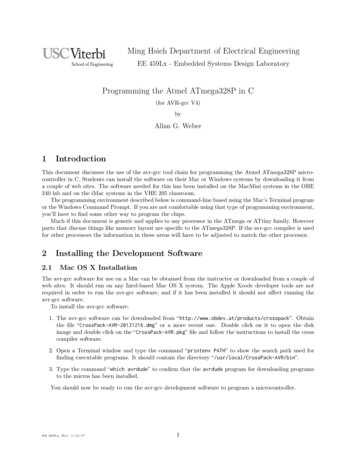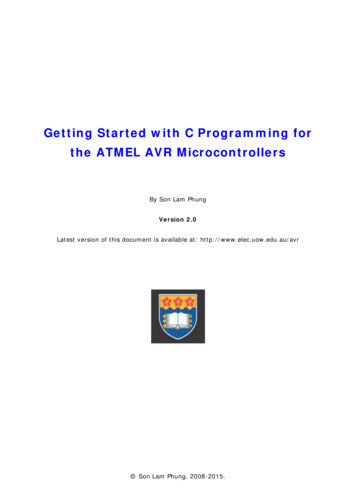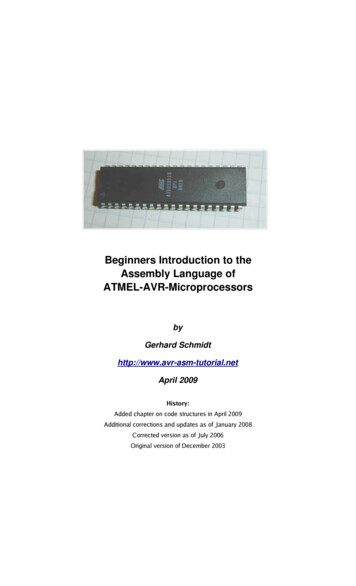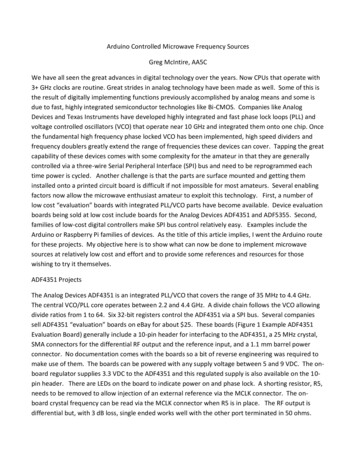
Transcription
Ming Hsieh Department of Electrical EngineeringEE 459Lx - Embedded Systems Design LaboratoryProgramming the Atmel ATmega328P in C(for AVR-gcc V4)byAllan G. Weber1IntroductionThis document discusses the use of the avr-gcc tool chain for programming the Atmel ATmega328P microcontroller in C. Students can install the software on their Mac or Windows systems by downloading it froma couple of web sites. The software needed for this has been installed on the MacMini systems in the OHE240 lab and on the iMac systems in the VHE 205 classroom.The programming environment described below is command-line based using the Mac’s Terminal programor the Windows Command Prompt. If you are not comfortable using that type of programming environment,you’ll have to find some other way to program the chips.Much if this document is generic and applies to any processor in the ATmega or ATtiny family. Howeverparts that discuss things like memory layout are specific to the ATmega328P. If the avr-gcc compiler is usedfor other processors the information in these areas will have to be adjusted to match the other processor.2Installing the Development Software2.1Mac OS X InstallationThe avr-gcc software for use on a Mac can be obtained from the instructor or downloaded from a couple ofweb sites. It should run on any Intel-based Mac OS X system. The Apple Xcode developer tools are notrequired in order to run the avr-gcc software, and if it has been installed it should not affect running theavr-gcc software.To install the avr-gcc software:1. The avr-gcc software can be downloaded from “http://www.obdev.at/products/crosspack”. Obtainthe file “CrossPack-AVR-20131216.dmg” or a more recent one. Double click on it to open the diskimage and double click on the “CrossPack-AVR.pkg” file and follow the instructions to install the crosscompiler software.2. Open a Terminal window and type the command “printenv PATH” to show the search path used forfinding executable programs. It should contain the directory “/usr/local/CrossPack-AVR/bin”.3. Type the command “which avrdude” to confirm that the avrdude program for downloading programsto the micros has been installed.You should now be ready to run the avr-gcc development software to program a microcontroller.EE 459Lx, Rev. 1/12/171
2.2Windows InstallationThe avr-gcc software for use on a Windows system can be obtained from the instructor or downloaded froma couple of web sites. It has been run on Windows 10 systems and probably runs on other versions.To install the avr-gcc software:1. The avr-gcc software can be downloaded from load the file “WinAVR-20100110-install.exe” or a more recent one. Double click on it to startthe installation. Follow the instructions and use the default settings and locations.2. Open a Command Prompt window (Windows button . . . search for “Command Prompt”) and type thecommand “path” to show the search path used for finding executable programs. It should contain thedirectories “C:\WinAVR-20100110\bin” and “C:\WinAVR-20100110\utils.3. Check that the software that downloads the programs to the Arduino has been installed by typing thecommand “avrdude -?”. If the program is working it should print out a bunch of stuff and at the endgive the version number of the program. Probably something like “avrdude version 5.10”.4. Connect one of the USBtiny programming modules to the computer. Windows will probably try toinstall a driver and this sometimes fails or it installs the wrong driver. Open the Device Manager(Windows button . . . search for “Device Manager”), find the USBtiny device and double click on it. Onthe Properties windows that come up, click on the Driver tab and then on the Update Driver button.On the next windows, click on the Browse button and, assuming you installed the WinAVR softwarein the default location, search for the directory “C:\WinAVR-20100110\utils\libusb\bin” and tell itto install the driver from that directory. With any luck the installation should succeed.You should now be ready to run the avr-gcc development software to program a microcontroller.Note: For a variety of reasons the author of this document has very little actual experience working withthe avr-gcc software on Windows systems, so the above instructions may be incomplete or wrong. Feel freeto send him any corrections, improvements or other recommended changes that would clarify the situationand benefit students in EE 459.2.3Linux InstallationFor Debian and Ubuntu Linux the following packages need to be installed.gcc - avrbinutils - avrgdb - avravr - libcavrdudeThe installation can be done with the commandsudo apt - get install gcc - avr binutils - avr gdb - avr avr - libc avrdudeThis may also cause several other packages to be installed. Check to see if the “make” program is presenton the system. If not also do “sudo apt-get install make” to install it.Some Linux systems refuse to program the chips due to protections on the device file that the downloadingprogram has to open to access the USBtiny programmer module. We have been able to fix this problem byadding a file to the /etc/udev/rules.d directory to correctly set the protection whenever the USBtiny isplugged in. Create a text file with a name like 43-usbtiny.rules that contains the following lines.# USBtinySUBSYSTEMS " usb " , ATTRS { idVendor } "1781" , ATTRS { idProduct } "0 c9f " , MODE : "0666"The file name does not have to match that shown above but needs to end in “.rules”. After adding (orchanging) the rule, either reboot or run the following command to make it take effect.udevadm control -- reload - rulesEE 459Lx, Rev. 1/12/172
3Editing FilesIn order to edit the text files associated with your project you will need a text editing program on yoursystem. The main requirement is that it be able to edit a file of plain text characters and not turn it intosomething like an RTF (Rich Text Format) file or some other word processing document type. There are alarge number of these available for free and it’s pretty much personal preference as to which one to use.For Unix-type systems (Mac OS X, Linux, FreeBSD, etc.) the most common command-line interface texteditors are probably “emacs”, “vi” or “vim” (improved vi). All are available in various forms from severalInternet sites. There are also numerous GUI type text editors like TextWranger and Aquamacs that willalso work.For Windows, the easiest one to find is probably “Notepad ”. One requirement of editing text files onWindows is that the editor be able to save files without adding a filename extension like “.txt”. If the editorinsists on adding the extension it is usually necessary to then use a Command Prompt window to renamethe file and remove the extension.4Starting a New ProjectThe easiest way to create a new project is to start with a couple of template files from the class web site.Create a new folder with a name for the new project.Note: It is strongly recommended that folder and file names do not contain spaces in them.You may use underscores if you wish (e.g. lab 3). Names with spaces are great whennavigating folders in a GUI, but not so great (i.e. very painful) when using command lineinterfaces.From the class web sites download the files “Makefile” and one of the sample AVR programs and put themboth in the project folder.The C file can be edited to create your program. The Makefile will also have to be edited to make surethe correct steps are done when building the project.5The MakefilePrograms can be compiled in several ways but one simple and efficient method is to use a utility programcalled “make”. This program is run from a command line interface and will do all the necessary compiling ofthe source code and linking of the object files to create the executable binary file. The make program does itswork on the basis of information in the text file “Makefile” and this file is the key to correct compiling anddownloading of the programs. It contains all the information and commands needed to compile the programand produce binary data that can be downloaded into the ATmega328P processor on the project board.One purpose of the Makefile is to describe “dependencies” between the various parts of the project.By knowing which program modules are dependent on other files, and examining the modification times ofthe various components, the make program only compiles the components of the program that need to becompiled. For a simple project this seems like more trouble than it’s worth, but for a complex project thatmight have hundreds of source code files, the make program is invaluable and well worth learning how to use.Once the proper information is in the Makefile, all the required program modules can be compiled andlinked together by just typing the command “make”. If a Makefile is copied from an existing project toa new one, only a a few lines at the top may have to be changed in order for the compiling, linking anddownloading to work properly. Most of the remaining information in it can usually be left unchanged.It’s important to note that the name of the file must be “Makefile” (or “makefile”). On occasion yourMac or Windows machine may try to add an extension to the file and call it something like “Makefile.txt”.This will prevent the make program from working. Some systems will add the extension, and then make theextension invisible so from the GUI the file looks like its name is Makefile but it’s really not.If the make command returns an error message about no Makefile found, use a Terminal or CommandPrompt window to go to the project folder and the ls (Mac or Linux) or dir (Windows) command shouldlist the files showing the full names. If necessary use the following command to fix the name.EE 459Lx, Rev. 1/12/173
rename makefile . txt makefilemv Makefile . txt Makefile -- on Windows -- on Mac or LinuxUsing your text editor, open the Makefile and look at the five lines at the top. These provide informationon what type of processor is being used, how to program it, and what files need to be compiled to buildthe executable program. Regardless of where the Makefile came from, it’s very important to make sure thecorrect information is at the top.DEVICECLOCKPROGRAMMEROBJECTSFUSES atmega328p9830400-c usbtiny -P usbmyprogram . o myfunctions . o-U hfuse : w :0 xd9 : m -U lfuse : w :0 xe0 : mThe DEVICE line contains the name of the microcontroller and must be correct for the program to compilecorrectly. For the ATmega328P this should be “atmega328p”.The CLOCK line tells the frequency of the clock being used in Hertz. This needs to be correct so any calls todelay functions will work and also for the communication between the your computer and the microcontroller.The PROGRAMMER line contains parameters used by the program that downloads the data to the microcontroller. This information is the same on all type of systems (Mac, Windows or Linux), but will differdepending on the type of programmer being used. For the USBtiny programmers in the black plastic boxeswith clear tops this should be “-c usbtiny -P usb”. For the blue AVRISP MkII programmers should be “-cavrispmkii -P usb”.The OBJECTS line lists all object modules that need to be linked together. If the program has been dividedinto several source files this line will contain more entries.The FUSE line give the parameters used to program the high and low fuse bytes (see Sec. 6.16). Thesecontrol various aspects of the microcontroller, such as the type of clock source. For programming individual328P’s on protoboards, the settings above should be used.Use the text editor to make any modifications to the Makefile that are needed and make sure that whenit’s saved the OS didn’t add a “.txt” or other extension to it.6Writing CodeWriting C code to be run on a microcontroller requires you to manage some of the low-level details of thesystem since a microcontroller has no operating system. Not only are you writing the application to be run onthe system but also the essential portions of OS code. The low-level details you must manage include readingand writing internal registers, writing assembly routines, registering interrupt service routines, dealing withmemory addressing issues, and some basic optimization issues.6.1Program InitializationThe avr-gcc software automatically includes in the project the start-up code to do things like initialize globalvariables and set up the processor stack. Other initialization tasks are determined by the programmablefuse settings. The programmer can just start their program and assume all the housekeeping tasks relatedto the microcontroller have been done.6.2Program TerminationUnlike writing a program on a larger computer, the microcontroller does not have an operating system thatcan take over control once the program is finished and exits. This means the program should never exit. Itshould always be doing something, such as running in an endless loop.while (1) {}EE 459Lx, Rev. 1/12/174
6.3Declaring VariablesIn most cases memory can be allocated the same as it would with any C program. However the microcontrollers have much less memory than is available for C programs on a general purpose computer so it isimportant to make efficient use it. Fixed-point variables, as opposed to floating point variables, should beused whenever possible since they take up less space in memory. The 328P processor does not have internalfloating point hardware so using floating point can slow down execution speed and increase program size.The native size for operating on data in the microcontroller is 8 bits. Whenever possible variables shouldbe declared as 8-bit values in order to reduce both the amount of RAM memory used and the amount ofcode generated to operate on the variables. Unless a values being stored in a variable are known to exceedthe limits of 8-bits, variables (and functions) should be declared as “unsigned char” for unsigned 0 to 255values, or “signed char” for -128
Ming Hsieh Department of Electrical Engineering EE 459Lx - Embedded Systems Design Laboratory Programming the Atmel ATmega328P in C (forAVR-gccV4)










